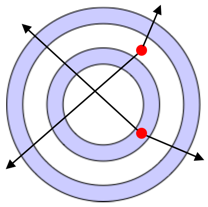填滿規則
數個 .NET 多平臺應用程式 UI (.NET MAUI) Shapes 類別具有 FillRule 類型的 FillRule 屬性。 這些包括 Polygon 、 Polyline 和 GeometryGroup 。
列舉 FillRule 會 EvenOdd 定義 和 Nonzero 成員。 每個成員都代表決定某個點是否在圖形填滿區域中的不同規則。
重要
所有圖形都會視為關閉,以填滿規則為目的。
EvenOdd
EvenOdd填滿規則會將光線從點繪製到任何方向的無限大,並計算光線交叉圖形內的線段數目。 如果這個數位是奇數,則點位於 內部。 如果這個數位是偶數,則點位於外部。
下列 XAML 範例會建立並轉譯複合圖形, FillRule 預設值為 EvenOdd :
<Path Stroke="Black"
Fill="#CCCCFF"
Aspect="Uniform"
HorizontalOptions="Start">
<Path.Data>
<!-- FillRule doesn't need to be set, because EvenOdd is the default. -->
<GeometryGroup>
<EllipseGeometry RadiusX="50"
RadiusY="50"
Center="75,75" />
<EllipseGeometry RadiusX="70"
RadiusY="70"
Center="75,75" />
<EllipseGeometry RadiusX="100"
RadiusY="100"
Center="75,75" />
<EllipseGeometry RadiusX="120"
RadiusY="120"
Center="75,75" />
</GeometryGroup>
</Path.Data>
</Path>
在此範例中,會顯示由一系列同心環形組成的複合圖形:

在複合圖形中,請注意,中央和第三個環形未填滿。 這是因為從這兩個環形中的任何一個點繪製的光線通過偶數段:

在上圖中,紅色圓形代表點,線條代表任意光線。 對於上點,兩個任意光線會分別通過偶數線段。 因此,不會填入點的環形。 對於下一點,兩個任意光線都會通過奇數的線段。 因此,已填入點的環形。
零
Nonzero填滿規則會將光線從點繪製到任何方向的無限大,然後檢查圖形區段跨越光線的位置。 從零計數開始,每次線段從左至右交叉光線,每次線段從右至左交叉光線時,計數就會遞增,每次線段從右至左交叉光線時遞減。 計算交叉之後,如果結果為零,則點位於多邊形外部。 否則,它是在裡面。
下列 XAML 範例會建立並呈現複合圖形,並將 FillRule 設定為 Nonzero :
<Path Stroke="Black"
Fill="#CCCCFF"
Aspect="Uniform"
HorizontalOptions="Start">
<Path.Data>
<GeometryGroup FillRule="Nonzero">
<EllipseGeometry RadiusX="50"
RadiusY="50"
Center="75,75" />
<EllipseGeometry RadiusX="70"
RadiusY="70"
Center="75,75" />
<EllipseGeometry RadiusX="100"
RadiusY="100"
Center="75,75" />
<EllipseGeometry RadiusX="120"
RadiusY="120"
Center="75,75" />
</GeometryGroup>
</Path.Data>
</Path>
在此範例中,會顯示由一系列同心環形組成的複合圖形:

在複合圖形中,請注意所有環形都會填滿。 這是因為所有線段都以相同的方向執行,因此從任何點繪製的光線會交叉一或多個區段,而交叉的總和不等於零:

在上方的影像中,紅色箭號代表繪製線段的方向,而黑色箭號代表從最內環中點執行的任意光線。 起始值為零,針對光線交會的每個線段,值會增加 1,因為線段由左至右與光線交會。
需要以不同方向執行的區段更複雜的圖形,才能更清楚地示範填滿規則的行為 Nonzero 。 下列 XAML 範例會建立與上一個範例類似的圖形,不同之處在于它是使用 PathGeometry EllipseGeometry 而不是 建立的:
<Path Stroke="Black"
Fill="#CCCCFF">
<Path.Data>
<GeometryGroup FillRule="Nonzero">
<PathGeometry>
<PathGeometry.Figures>
<!-- Inner ring -->
<PathFigure StartPoint="120,120">
<PathFigure.Segments>
<PathSegmentCollection>
<ArcSegment Size="50,50"
IsLargeArc="True"
SweepDirection="CounterClockwise"
Point="140,120" />
</PathSegmentCollection>
</PathFigure.Segments>
</PathFigure>
<!-- Second ring -->
<PathFigure StartPoint="120,100">
<PathFigure.Segments>
<PathSegmentCollection>
<ArcSegment Size="70,70"
IsLargeArc="True"
SweepDirection="CounterClockwise"
Point="140,100" />
</PathSegmentCollection>
</PathFigure.Segments>
</PathFigure>
<!-- Third ring -->
<PathFigure StartPoint="120,70">
<PathFigure.Segments>
<PathSegmentCollection>
<ArcSegment Size="100,100"
IsLargeArc="True"
SweepDirection="CounterClockwise"
Point="140,70" />
</PathSegmentCollection>
</PathFigure.Segments>
</PathFigure>
<!-- Outer ring -->
<PathFigure StartPoint="120,300">
<PathFigure.Segments>
<ArcSegment Size="130,130"
IsLargeArc="True"
SweepDirection="Clockwise"
Point="140,300" />
</PathFigure.Segments>
</PathFigure>
</PathGeometry.Figures>
</PathGeometry>
</GeometryGroup>
</Path.Data>
</Path>
在此範例中,會繪製一系列的弧線段,但未關閉:

在上圖中,中央的第三個弧線不會填滿。 這是因為在路徑中交叉線段之指定光線中的值總和為零:

在上圖中,紅色圓圈代表一個點、黑色線條代表從非填滿區域中的點移出的任意光線,而紅色箭號代表繪製線段的方向。 如所見,穿越線段的光線值總和為零:
- 以對角線向右移動的任意光線會交叉兩個以不同方向執行的區段。 因此,區段會彼此取消,並提供值為零的值。
- 以對角線向左移動的任意光線總共跨越了六個線段。 不過,交叉點會彼此取消,使零是最終的總和。
零的總和會導致環形未填滿。
 流覽範例
流覽範例